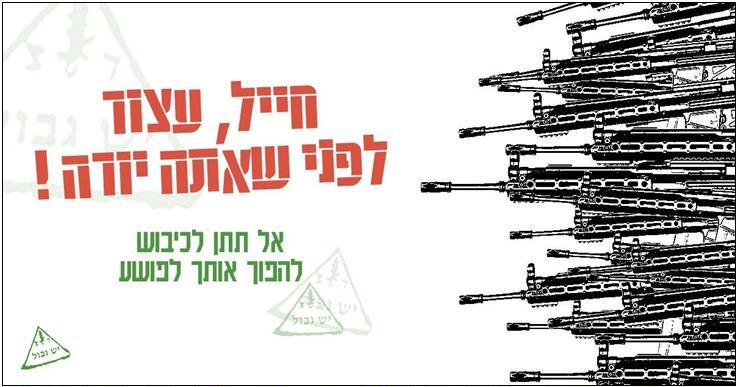Mass demonstrations along Israel’s perimeter fence with the Gaza Strip took place on Friday, June 8, for the eleventh consecutive week, as part of the “Great March of Return.” Israeli forces killed four Palestinians, and injured 618 demonstrators, according to the Ministry of Health (MoH) in Gaza. 254 of the injuries were transferred to hospitals, including 117 wounded by live ammunition, according to the MoH. Eight of the wounded are in critical condition. One Israeli soldier was also reportedly slightly injured.

An ad by the Yesh Gvul refusers’ movement: “Soldier, Stop before you shoot! Don’t let the occupation turn you into a criminal.”
An Israeli sniper shot dead Yousef al-Fasih, 29, who was participating in the border protests to the east of Gaza City. The army also shot and killed 15-year-old Haitham al-Jamal while he was participating in the protests at Gaza-Israel border to the east of Khan Younes, in the southern Gaza Strip. Prior to this, Ziad Jadallah Bureim was also shot dead in the same locale. The fourth fatality, Imad Nabil Abu Darabi, 26, was killed by Israeli forces along the border to the east of Jabalia, in the northern Gaza Strip.
Friday’s casualty toll was the highest since the demonstrations on May 14, when over 60 Palestinians were killed and 2,000 were injured, the highest casualty toll in the Gaza Strip in a single day since the 2014 hostilities.
Between 20,000 and 30,000 people participated in the Friday protests which set out from five tent camps located some 600-700 meters from the perimeter fence, marking the greatest number of participants in recent weeks. As in previous weeks, hundreds of demonstrators marched from the tent camps towards the fence, burned tires and threw rocks and other objects at Israeli forces, and flew paper kites and gas balloons loaded with flammable materials; the latter have damaged agricultural land and crops in southern Israel in recent weeks. Israel reported that a number of explosive devices and a grenade were used against their forces and that shooting took place against an Israeli post in northern Gaza. The Israeli authorities had reinforced their forces, including deploying additional snipers, in anticipation of Friday’s protests. The day before, the Israeli air force dropped pamphlets over the tent camps, as well as the main cities in Gaza, warning people not to participate in the demonstrations and to stay away from the fence and to refrain from attempting to breach or damage it.
Since March 30, according to the MoH in Gaza, Israeli forces have killed 101 Palestinians, including at least 13 minors, during the course of the “Great March of Return” demonstrations. More than 13,000 Palestinians have been wounded. In addition, 34 Palestinians have been killed during the same period in contexts others than demonstrations, including six people whose bodies are reportedly being withheld by the Israeli authorities. Five Israeli soldiers have reportedly been injured since the end of March.
The large number of casualties among demonstrators since March 30, in particular the high percentage wounded by live ammunition, has raised concerns about excessive use of force, alongside calls for independent and transparent investigations of these incidents, including one made by the UN Secretary-General. The Israeli authorities have stated that many of the fatalities were members of Hamas and other armed groups and have stated that an investigation will review the use of force, including incidents of fatal shootings.
The Palestinian casualties have included health care workers. From March 30 to June 3, 321 health workers and 41 ambulances have been involved in violent incidents, according to data provided by the Palestinian Ministry of Health, the Palestinian Red Crescent Society, the Palestinian Medical Relief Society (PMRS) and the Union of Health Work Committees. Of those, 23 were hit by live ammunition, causing two fatalities, including a 20-year-old woman, Razan al-Najjar, who was volunteering with the PMRS on June 1.
Gaza’s already overstretched health sector has been struggling to cope with the mass influx of casualties. Medical supplies are significantly depleted and access to healthcare for non-trauma patients is being compromised, with non-surgical wards converted to surgical wards to cope with the huge influx of trauma patients. These developments have exacerbated the already fragile situation of the health system in Gaza as a result of over 10 years of blockade, the deepening intra-Palestinian political divide, a deteriorating energy crisis, and inconsistent payment of public sector medical personnel.


